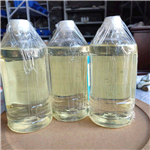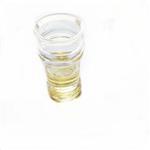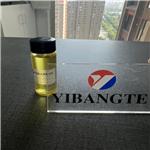Dimethyl disulfide
- CAS No.
- 624-92-0
- Chemical Name:
- Dimethyl disulfide
- Synonyms
- DMDS;1,2-dimethyldisulfane;DIMETHYL DISULPHIDE;mds;Disulfide,dimethyl;(CH3S)2;DiMethyl disul;Dimethyldisulfid;143B;FEMA 3536
- CBNumber:
- CB8229876
- Molecular Formula:
- C2H6S2
Lewis structure
2.png)
- Molecular Weight:
- 94.2
- MDL Number:
- MFCD00008561
- MOL File:
- 624-92-0.mol
| Melting point | -85 °C |
|---|---|
| Boiling point | 109 °C(lit.) |
| Density | 1.0625 |
| vapor density | 3.24 (vs air) |
| vapor pressure | 22 mm Hg ( 20 °C) |
| refractive index |
n |
| FEMA | 3536 | DIMETHYL DISULFIDE |
| Flash point | 76 °F |
| storage temp. | Flammables area |
| solubility | 2.7g/l |
| form | Liquid |
| Specific Gravity | 1.0647 (20/4℃) |
| color | Clear yellow |
| Odor | at 0.10 % in propylene glycol. sulfurous vegetable cabbage onion |
| Odor Type | sulfurous |
| Viscosity | 0.594mm2/s |
| explosive limit | 1.1-16.1%(V) |
| Odor Threshold | 0.0022ppm |
| Water Solubility | <0.1 g/100 mL at 20 ºC |
| JECFA Number | 564 |
| BRN | 1730824 |
| Exposure limits | ACGIH: TWA 0.5 ppm (Skin) |
| Dielectric constant | 9.7699999999999996 |
| Stability | Stable. Incompatible with strong bases, strong oxidizing agents, strong reducing agents. Flammable. |
| InChIKey | WQOXQRCZOLPYPM-UHFFFAOYSA-N |
| LogP | 1.91 at 20℃ |
| Substances Added to Food (formerly EAFUS) | METHYL DISULFIDE |
| CAS DataBase Reference | 624-92-0(CAS DataBase Reference) |
| NCI Dictionary of Cancer Terms | MDS |
| FDA UNII | 3P8D642K5E |
| NIST Chemistry Reference | Disulfide, dimethyl(624-92-0) |
| EPA Substance Registry System | Methyl disulfide (624-92-0) |
SAFETY
Risk and Safety Statements
| Symbol(GHS) |     GHS02,GHS06,GHS08,GHS09 |
|||||||||
|---|---|---|---|---|---|---|---|---|---|---|
| Signal word | Danger | |||||||||
| Hazard statements | H225-H301+H331-H317-H319-H336-H370-H410 | |||||||||
| Precautionary statements | P210-P273-P280-P301+P310-P303+P361+P353-P304+P340+P311 | |||||||||
| Hazard Codes | F,Xn,N,T+ | |||||||||
| Risk Statements | 11-20/22-36-51/53-36/37/38-26-22-36/37 | |||||||||
| Safety Statements | 26-61-45-38-36/37/39-28A-16-60-57-39-29 | |||||||||
| RIDADR | UN 2381 3/PG 2 | |||||||||
| WGK Germany | 2 | |||||||||
| RTECS | JO1927500 | |||||||||
| Autoignition Temperature | 304 °C | |||||||||
| TSCA | Yes | |||||||||
| HazardClass | 3 | |||||||||
| PackingGroup | II | |||||||||
| HS Code | 29309070 | |||||||||
| Toxicity | LD50 orally in Rabbit: 290 - 500 mg/kg | |||||||||
| NFPA 704 |
|
Dimethyl disulfide price More Price(32)
| Manufacturer | Product number | Product description | CAS number | Packaging | Price | Updated | Buy |
|---|---|---|---|---|---|---|---|
| Sigma-Aldrich | W353604 | Dimethyl disulfide ≥98%, FG | 624-92-0 | 1kg | $92.9 | 2024-03-01 | Buy |
| Sigma-Aldrich | W353604 | Dimethyl disulfide ≥98%, FG | 624-92-0 | 5kg | $347 | 2024-03-01 | Buy |
| Sigma-Aldrich | W353604 | Dimethyl disulfide ≥98%, FG | 624-92-0 | 10Kg | $488 | 2024-03-01 | Buy |
| Sigma-Aldrich | W353600 | Dimethyl disulfide natural, ≥98%, FG | 624-92-0 | 50g | $381 | 2024-03-01 | Buy |
| Sigma-Aldrich | W353600 | Dimethyl disulfide natural, ≥98%, FG | 624-92-0 | 250g | $1330 | 2024-03-01 | Buy |
Dimethyl disulfide Chemical Properties,Uses,Production
Description
Dimethyl disulfide has a diffuse intense onion odor. It is nonlachrymatory. Ironically, although many find its odor objectionable at high concentrations as noted above, when diluted, its aroma has also been described as pleasant. Dimethyl disulfide is often used in combination with other flavor compounds in food products, including baked goods, cheese, frozen dairy products, meat products, soups, savory flavors, fruit flavors, soft candy, gelatin, puddings, and both alcoholic and nonalcoholic beverages.
Chemical Properties
colourless to yellow liquid with a very unpleasant smell, insoluble in water, Soluble in ethanol, ethyl ether and acetic acid. It is a strong odor component irritant which is also included in garlic and has been designated as a specific malodorous substances based on the Offensive Odor Control Law. Its detection threshold shows 0.002 ppm, which senses a low concentration equivalent to Dimethyl sulfide.
Occurrence
Reported found in sour cherry, guava, melon, peach, pineapple, strawberry, cabbage, kohlrabi, onion, garlic, shallot, leek, chive, peas, potato, rutabaga, tomato, parsley, breads, many cheeses, yogurt, milk, egg, fish, meats, hop oil, beer, Scotch whiskey, cognac, grape wines, cocoa, coffee, peanut, peanut butter, pecan, potato chips, oats, soybean, beans, mushrooms, trassi, macadamia nut, mango, cauliflower, broccoli, brussels sprouts, rice, radish, sukiyaki, sake, watercress, malt, wort, krill, southern pea, loquat, sapodilla, shrimp, oyster, crab, crayfish, clam, scallops and squid.
Uses
Industrially, Dimethyl disulfide is also used as a sulfiding agent to catalyze reactions in oil refineries and other industries. It has a low flash point of 16 ℃ (61 °F) that presents fire hazards during refinery usage. Due to its strong odor and low flash point, Dimethyl disulfide typically requires storage under nitrogen pressure in closed containers.
Dimethyl disulfide has a sulfurous odor similar to that of garlic and decaying fish. Because of the distinctive odor of sulfur compounds, similar to DMDS, they are often added to natural gas and propane to warn of leaks and protect people. Therefore, the odor of a DMDS fumigation can be mistaken for a gas leak. DMDS has an odor threshold of approximately 7 ppb, which is about 8 times less than the health‐based level considered by the EPA to be safe (55 ppb).
Uses
Dimethyl disulfide is used as an intermediate as well as a food additive in onion, garlic, cheese, meats, soups, savory flavors and fruit flavors. It is used in oil refineries as a sulfiding agent. It is used to alfa substitute 2-methylfuran-acrolein to produce food stuff. It is involved in the preparation of 4-(methylthio)phenol. Further, it is used to replace methyl mercaptan as a jet fuel additive. It finds application in artificial flavoring agent and a corrosion inhibitor. In addition to this, it serves as an effective soil fumigant in agriculture.
Preparation
Dimethyl disulfide can be prepared by the reaction between imethyl sulfate and sodium sulfide. under stirring, sulfur powder was added into sodium sulfide solution. The above reaction system was heated Up to 80-90℃, after reaction for 1 h, cooled to about 30 ℃. Dimethyl sulfate was dropped into the reaction system and the reaction was continued for 2h. Then, distillation, stratification, Separating waste alkali liquor, then through distillation and final products are prepared.
In industry,dimethyl sulfate method is adopted to synthesize dimethyl disulfide.
Na2S+S→Na2S2Na2S2+(CH3)2SO4→CH3SSCH3+Na2SO4
From magnesium methyl iodide and S2Cl2, or from S2S2 and sodium methyl sulfate; also from methyl bromide and sodium thiosulfate, after which the resulting sodium methylthiosulfate is heated to yield dimethyl disulfide.
Definition
ChEBI: Dimethyl disulfide is an organic disulfide that is methane in which one of the hydrogens has been replaced by a methyldisulfanyl group. It has a role as a xenobiotic metabolite.
Aroma threshold values
Detection: 0.16 to 1.2 ppb. Recognition: 90 ppb
General Description
A colorless oily liquid with a garlic-like odor. Denser than water and slightly soluble in water. Flash point 40°F. Vapors heavier than air. May irritate skin and eyes. Used to make other chemicals.
Air & Water Reactions
Highly flammable. Slightly soluble in water.
Reactivity Profile
DMDS is a reducing agent. A dangerous fire hazard when exposed to oxidizing materials. Emits toxic fumes of oxides of sulfur when heated to decomposition or on contact with acids [Sax, 9th ed., 1996, p. 1320].
Health Hazard
May cause toxic effects if inhaled or absorbed through skin. Inhalation or contact with material may irritate or burn skin and eyes. Fire will produce irritating, corrosive and/or toxic gases. Vapors may cause dizziness or suffocation. Runoff from fire control or dilution water may cause pollution.
Fire Hazard
HIGHLY FLAMMABLE: Will be easily ignited by heat, sparks or flames. Vapors may form explosive mixtures with air. Vapors may travel to source of ignition and flash back. Most vapors are heavier than air. They will spread along ground and collect in low or confined areas (sewers, basements, tanks). Vapor explosion hazard indoors, outdoors or in sewers. Runoff to sewer may create fire or explosion hazard. Containers may explode when heated. Many liquids are lighter than water.
Flammability and Explosibility
Highly flammable
Safety Profile
Poison by inhalation. A very dangerous fire hazard when exposed to heat, flame, or oxidzers. Can react vigorously with oxiduing materials. See also SULFIDES.
Potential Exposure
PrimaryIrritant. This material may be used as an organicintermediate
First aid
If this chemical gets into the eyes, remove anycontact lenses at once and irrigate immediately for at least15 min, occasionally lifting upper and lower lids. Seek medical attention immediately. If this chemical contacts theskin, remove contaminated clothing and wash immediatelywith soap and water. Seek medical attention immediately. Ifthis chemical has been inhaled, remove from exposure,begin rescue breathing (using universal precautions, including resuscitation mask) if breathing has stopped and CPR ifheart action has stopped. Transfer promptly to a medicalfacility. When this chemical has been swallowed, get medical attention. Give large quantities of water and inducevomiting. Do not make an unconscious person vomit.
storage
Color Code—Red: Flammability Hazard: Store ina flammable liquid storage area or approved cabinet awayfrom ignition sources and corrosive and reactive materials.Prior to working with Dimethyl disulfide you should betrained on its proper handling and storage. Before enteringconfined space where this chemical may be present, checkto make sure that an explosive concentration does not exist.Store in tightly closed containers in a cool, well-ventilatedarea away from any form of moisture, oxidizers, acids.Metal containers involving the transfer of this chemicalshould be grounded and bonded. Where possible, automatically pump liquid from drums or other storage containers toprocess containers. Drums must be equipped with self-closing valves, pressure vacuum bungs, and flame arresters. Useonly nonsparking tools and equipment, especially whenopening and closing containers of this chemical. Sources ofignition, such as smoking and open flames, are prohibitedwhere this chemical is used, handled, or stored in a mannerthat could create a potential fire or explosion hazard.Wherever this chemical is used, handled, manufactured, orstored, use explosion-proof electrical equipment andfittings.
Shipping
This compound requires a shipping label of“FLAMMABLE LIQUID.” It falls in Hazard Class 3 andPacking Group II.
Purification Methods
Pass it through neutral alumina before use. [Trost Chem Rev 78 363 1978, Beilstein 1 IV 1281.]
Toxicity evaluation
Very little information is available on mechanism of toxicity. Although the authors of one experimental animal study suggested that methyl disulfide toxicity resembles that of hydrogen sulfide, it is not at all clear that cytochrome oxidase inhibition can result from methyl disulfide exposure. Mechanistically hydrogen sulfide is classified as a chemical asphyxiant because of its known ability to disrupt electron transport and oxidative phosphorylation by interaction with the enzyme cytochrome oxidase. Other sources classify methyl disulfide a simple asphyxiant, which means that it is nonreactive with enzymes or other cell components and simply displaces oxygen in the air. Some information indicates that neurotoxicity to insects results when methyl disulfide disrupts calcium-activated potassium channels in insect pacemaker neurons.
Incompatibilities
Forms explosive mixture with air.Contact with water or acids forms flammable and toxicvapors of hydrogen sulfide. Contact with oxidizing materials or acids can cause a violent reaction.
Dimethyl disulfide Preparation Products And Raw materials
Raw materials
1of2
Preparation Products
1of3
| Supplier | Tel | Country | ProdList | Advantage | |
|---|---|---|---|---|---|
| Langfang Hawk Techology & Development Co, Ltd. | 0316-2224727,2224728,2224729 | 38755326@qq.com | China | 23 | 58 |
| Shandong Zhishang New Material Co., Ltd. | +8617653113209 | sales002@sdzschem.com | China | 3050 | 58 |
| Hebei Mojin Biotechnology Co., Ltd | +8613288715578 | sales@hbmojin.com | China | 12453 | 58 |
| Henan Tianfu Chemical Co.,Ltd. | +86-0371-55170693 +86-19937530512 | info@tianfuchem.com | China | 21695 | 55 |
| Hangzhou FandaChem Co.,Ltd. | 008657128800458; +8615858145714 | fandachem@gmail.com | China | 9352 | 55 |
| Hefei TNJ Chemical Industry Co.,Ltd. | +86-0551-65418679 +86-18949832763 | info@tnjchem.com | China | 2989 | 55 |
| Tianjin Zhongxin Chemtech Co., Ltd. | +86-022-66880623 +8618622897568 | sales@tjzxchem.com | China | 559 | 58 |
| career henan chemical co | +86-0371-86658258 | sales@coreychem.com | China | 29914 | 58 |
| Hubei Jusheng Technology Co.,Ltd. | 18871490254 | linda@hubeijusheng.com | CHINA | 28180 | 58 |
| Hebei Guanlang Biotechnology Co., Ltd. | +86-19930503282 | alice@crovellbio.com | China | 8822 | 58 |
Related articles
- Dimethyl disulfide: Toxicity, Applications, storage, Preparation
- Dimethyl disulfide (DMDS) is a colorless to pale yellow liquid with a strong, unpleasant odor. It is an organic compound compo....
- Apr 24,2023
- Applications of Dimethyl disulfide
- Dimethyl disulfide(MDMS) appears as a colorless oily liquid with a garlic-like odor. Dimethyl disulfide is denser than water a....
- Nov 22,2019
View Lastest Price from Dimethyl disulfide manufacturers
| Image | Update time | Product | Price | Min. Order | Purity | Supply Ability | Manufacturer | |
|---|---|---|---|---|---|---|---|---|
 |
2023-09-06 | Dimethyl disulfide
624-92-0
|
US $0.00 / KG | 1KG | 99% | 500000kg | Hebei Guanlang Biotechnology Co., Ltd. | |
 |
2023-08-24 | Dimethyl disulfide
624-92-0
|
US $0.00 / KG | 1KG | 99% | 50000KG/month | Hebei Mojin Biotechnology Co., Ltd | |
 |
2023-08-01 | Dimethyl disulfide
624-92-0
|
US $0.00-0.00 / kg | 1kg | 0.99 | 50000kg | Hebei Yibangte Import and Export Co. , Ltd. |
-

- Dimethyl disulfide
624-92-0
- US $0.00 / KG
- 99%
- Hebei Guanlang Biotechnology Co., Ltd.
-

- Dimethyl disulfide
624-92-0
- US $0.00 / KG
- 99%
- Hebei Mojin Biotechnology Co., Ltd
-

- Dimethyl disulfide
624-92-0
- US $0.00-0.00 / kg
- 0.99
- Hebei Yibangte Import and Export Co. , Ltd.







